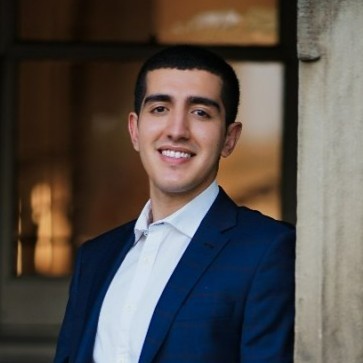The New Frontier

Investing in the Digital World
Disclaimer: This article is only intended to provide you with general information. It is neither an offer to sell nor a solicitation of an offer to purchase any security and does not constitute, and should not be construed as, investment advice. Any statement about a particular investment or company is not an endorsement or recommendation to buy or sell any such security. The article is not intended to provide legal, accounting, financial or tax advice, and should not be relied upon in that regard. You are encouraged to seek independent advice. Every effort has been made to ensure that the article is accurate as of the date of first publication; however, we cannot guarantee that it is accurate, complete, or current at all times. The article may contain forward-looking information that reflects our current expectations or forecasts of future events. Forward-looking information is inherently subject to, among other things, risks, uncertainties, and assumptions that could cause actual results to differ materially from those expressed herein.
In December of 2020, I took a portion of my year-end bonus and dropped it into Bitcoin. With skin in the game, I began my crypto learning journey. Over the next 12 months, I spent thousands of hours consuming educational content on all aspects of crypto. I spent several weeks enrolled in an MIT Media Lab course learning from none other than crypto arch-villain, Gary Gensler (current Chairperson of the US Securities and Exchange Commission). I listened to countless hours of podcast content, read research reports and academic studies and opened accounts on various platforms to take part in a variety of crypto related activities (moving crypto from one wallet to another, buying NFTs, staking, lending, etc.)
All told, I walked away with a ton of theoretical and practical knowledge on blockchain technology, digital finance, digital assets, and more. Investing in crypto is not for the feint of heart. It’s complex, fast moving, still partially unregulated and full of bad actors. Even the largest and most sophisticated investors can find themselves racking up losses in crypto as was the case with Quebec pension plan, Caisse de Dépôt et Placement du Québec, whose $150 Million investment in crypto digital finance (“DeFi”) protocol, Celsius, has likely been wiped out after Celsius declared bankruptcy.
Today’s post is about three industry professionals who have shared their unique perspectives with me on the evolving crypto ecosystem. The bottom line for retail investors is to tread with caution. Crypto, in its totality, is an emerging technology ecosystem that is still very early in its lifecycle and subject to many risks. Retail investors interested in crypto should carefully assess whether to participate in the space, how much of their overall portfolio to allocate, and, very importantly, how to actually go about making the allocation. In my opinion, there’s no question that crypto will eventually play a substantial role in future economic life. The open question, at least from my perspective, is what that role will be and who will truly benefit. Now, let’s turn to the interviews!
Abdennour Aissaoui

On Background
Abdennour spent six years at University of Toronto where he completed his BBA with a minor in Computer Science followed by a Masters in Financial Engineering. During his time at UofT, he completed internships at HOOPP (one of the largest pension funds in Canada) as well as hedge fund, Picton Mahoney. In between school and internships, he developed a portfolio construction tool, NestQ, to flex his coding, data analytics and investment portfolio analysis skill sets.
Since graduating, Abdennour has parceled up his time between teaching at UofT, software engineering at a Canadian robo-advisor and developing technology for a digital finance (“DeFi”) startup aiming to develop the crypto ‘Bloomberg’ platform.
His perspective on crypto has been shaped by both professional and personal experiences. Originally hailing from Algeria, Abdennour has seen the difficulties people in developing countries can face due to currency volatility and banking system failures. On the professional front, he has built algorithms and research tools for a DeFi startup, which has given him deep, unique perspectives on the inner workings of one of the largest parts of the crypto ecosystem.
DeFi refers to digital financial services that leverage blockchain related technology such as smart contracts to offer financial services such as lending and investing in a highly automated manner. The theoretical benefits of DeFi include faster transaction times, lower transaction fees and greater transparency
Abdennour believes that crypto, with an emphasis on DeFi, can provide practical benefits for regular people, however, at present, the space is rife with misinformation, bad actors and mixed quality technology, which makes it challenging to navigate for the average retail investor.
On Retail Investor Participation in Crypto
Abdennour’s view on retail investor participation is colored by his own experiences investing in a variety of crypto assets. He suffered losses in the space as a result of the now defunct stablecoin, UST, the collapse of DeFi protocol, Celsius, as well as investments in lesser known crypto tokens. He believes that retail investors interested in crypto should focus on parts of the market that have been resilient to security issues, fraud, and other challenges. BTC, ETH and time tested DeFi protocols such as Uniswap, and AAVE, in his opinion, are where retail investors should concentrate their exposures. He also feels strongly that retail investors should avoid allocating to speculative tokens and/or projects unless they have done substantial due diligence and are comfortable with the risks they are taking on.
On Predicting the Future of Crypto
While not one to make bold claims about what the future may hold, Abdennour believes the crypto ecosystem will face headwinds in the coming years due to competition, new challenges from traditional financial service providers, regulation and internal industry conflict. In his words, “…there is war ahead for crypto…”. Still he holds out some optimism that over time more use cases will emerge, security issues will be addressed and crypto may begin fulfilling its role in improving the economic lives of regular people around the world.
Michael Leung

On Background
Mike’s industry experience spans trading, traditional portfolio management, alternative investments and now crypto. Mike started out in the late ‘90s as an equity derivatives trader at a large bank. He then went on to cover high yield fixed income as an investment analyst at an asset management firm before changing gears to lead the build out of a private debt business for a well known wealth management firm. In 2021, Mike joined Aquanow, a global digital assets infrastructure and services business that provides a variety of crypto/digital asset services to market participants. Since then he’s been neck deep in the crypto space working alongside seasoned capital market veterans to build and grow a crypto-native business. Headquartered in Vancouver, Aquanow is amongst the leading Canadian crypto services businesses providing services to market participants in more than 30 countries around the world.
Mike’s professional experiences make him uniquely qualified to speak to the rapidly evolving crypto space. As a participant in traditional finance, he’s seen the inner workings of the capital markets industry and recognizes the potential value that can be unlocked by blockchain technology and its tokenized forms. He also recognizes that the space is early in its development lifecycle and may not necessarily be suitable for all investors.
On Crypto Real World Use Cases
Mike highlights stablecoins as one particular area of the crypto ecosystem that is already creating substantial real world value.
According to Seeking Alpha, Stablecoins are kinds of cryptocurrency whose value is pegged to a fiat currency like the U.S. dollar, other cryptocurrencies, or a commodity like oil or gold. They provide users with the benefit of the security and immediate payment processing that digital currencies offer, without the price volatility of traditional cryptocurrencies.
Today, stablecoins make up roughly 15% of the total market capitalization of crypto. Mike sees stablecoins as a means for institutions and individuals to move money from one location to another with faster speeds (near instant settlement), lower costs (less intermediary and transaction fees) and the security of blockchain ledger technology. This may not mean much for folks in countries like Canada where the financial system is efficient, but many countries suffer from currency devaluation, banking system failures, conflict and rampant inflation, so having access to cash in the form of stablecoins is a life altering innovation.
On Retail Investor Participation in Crypto
In Mike’s view, the crypto ecosystem is the hub of fintech innovation and there is a lot of excitement around the potential use cases for crypto-native applications and technology. Mike isn’t the only one as the venture capital industry continues to pour capital into the crypto ecosystem, even with the ongoing volatility and drawdowns in cryptocurrency tokens.
However, given that the space is still in its infancy, is extremely volatile and subject to underhanded activity, he cautions retail investors to think carefully about how much capital to put to work in the space and what crypto-assets to allocate into. He highlights Bitcoin as a way to participate in some of crypto’s potential upside without the substantial risk of investing into speculative or unproven projects. Overall, he echoes the sentiment of all the interviewees I spoke to, which is to tread with caution in the cryptocurrency arena.
On Predicting the Future of Crypto
Mike believes that the crypto landscape 3-5 years from now will look materially different from how it looks today. Today’s leading crypto technologies, protocols, applications and blockchains may not be the market leaders of tomorrow. He highlighted the development of the smart phone market as an example, where leading phones like Blackberry and the Palm Pilot were ultimately unseated by the iPhone. This ties back to the need to tread with caution and not over allocate to crypto/digital assets given the speed with which things are changing in the space.
Claire Van Wyk-Allan

Claire has spent over a decade in the Canadian investment management industry having worked at a leading hedge fund and a leading Canadian bank before ultimately joining the Alternative Investment Management Association (“AIMA” where she is now Managing Director and Head of Canada. As Head of AIMA Canada, Claire occupies a unique space in the alternative investments industry with direct access to regulators, institutional investors, senior industry leaders, service providers and more.
The Alternative Investment Management Association (AIMA) is the global representative of the alternative investment industry, with more than 2,100 corporate members in over 60 countries. AIMA’s fund manager members collectively manage more than US$2.5 trillion in assets. AIMA draws upon the expertise and diversity of its membership to provide leadership in industry initiatives such as advocacy, policy and regulatory engagement, educational programmes and sound practice guides. AIMA works to raise media and public awareness of the value of the industry.
As a result of Claire’s professional experience, she’s had a front row view of how the alternative investments industry is responding to, and evolving with, the crypto ecosystem. This includes how hedge funds have ramped up activity in the crypto space, how institutional investors have ramped up their research and exposure, how regulators are tackling issues and devising policy, and how service providers such as custodians, fund administrators, liquidity providers, etc., are improving their offerings to provide crypto market participants with greater security, efficiency and transparency.
On the Alternative Investment Industry’s Response to Crypto
AIMA itself began paying attention to crypto in 2017, though enhanced this in 2020 on the back of greater interest from its hedge fund membership. As more and more hedge funds began entering the crypto market, AIMA began to formalize it’s support for the crypto industry, which included establishing a dedicated global working group, organizing and sponsoring industry events/conferences and working more closely with regulators on policy initiatives in various jurisdictions.
From Claire’s perspective, crypto as an investable asset class, presents opportunity for hedge fund investors who can utilize their sophisticated investment tool kits to generate returns in highly volatile, often asymmetrical investment arenas. In fact, a research survey conducted by PwC finds that 38% of traditional hedge funds are now investing in the crypto space, up from 21% one year ago. While these numbers are likely to ebb and flow as crypto markets gyrate, they are indicative of broader investment trends, which seem to suggest that crypto is increasingly attractive to a variety of sophisticated investors.
Zooming out, and including other groups of sophisticated investors, such as institutional investors (e.g. pension funds, sovereign wealth funds), it would appear that digital assets (crypto) are here to stay. Even large-scale collapses in the crypto market don’t seem to be deterring sophisticated investors from continuing to learn and explore the space and slowly expanding their coverage/exposure over time in light of the large-scale infrastructure shift blockchain technology presents across sectors and industries.
On Service Providers in the Crypto Ecosystem
Another unique perspective Claire shared was on the ongoing ‘institutionalization’ of crypto ecosystem service providers. Think of service providers as the companies behind the scenes making sure your crypto investments are being stored securely, moved with minimal costs/in-efficiencies, accounted for accurately, etc. AIMA works hand in hand with alternative industry service providers to produce and distribute best practices around operational activities. They’ve now expanded their best practice guides to include crypto ecosystem service providers and are seeing broad based adoption of these practices, which in turn means safer onramps and transacting for crypto market participants. With that said, Claire mentioned that it’s still early days and crypto service providers, in some instances, are still working through coming up the curve on generally accepted best practices for operational activities within alternative investments.
On Retail Investor Participation in Crypto
From Claire’s view, retail investors who want to participate in the crypto investment opportunity should pay very close attention to how much capital they put at risk. The risk being that they may never see that capital again i.e. a total loss. With that said, Claire feels the crypto opportunity is too big to ignore but may not be suitable for all retail investors, particularly those with low tolerance for volatility or loss. Those investors unwilling to put the effort in to study the crypto exposures they want to take on are better off sitting out as the risks are plenty.
On Predicting the Future of Crypto
Claire’s predictions are interconnected with the research AIMA conducts to assess the alternative investment industry’s sentiment toward the evolving crypto space. She sees crypto adoption continuing to grow with more institutional participation in the space looking ahead. She also believes many of the regulatory challenges plaguing the crypto industry today are likely to be resolved in the next 3-5 years, which, for better or for worse, will bring stability and safety to the space, driving further adoption. She also believes there will be greater integration between traditional financial services and crypto-native services as traditional finance races to catch-up. She believes there will be consolidation within the space as many of the smaller crypto ecosystem players are absorbed by larger incumbents or traditional financial service companies looking to enter the space.
In her words, “…I see the space growing in breadth, depth, and capital flows in five years.”
My takeaway from these interviews, in summary, is that some of the smartest people from traditional finance are making there way into the crypto ecosystem. This is proving out at scale across the world and potentially indicative of crypto’s growing relevance going forward. Additionally, the regulatory advances that have been made, and continue to be made, within crypto, further evidence that the space is going mainstream and will become more broadly integrated with financial life, over time. A great example is the ongoing crypto related efforts of credit card giants, Visa and Mastercard. With that said, retail investors have to continue to be vigilant when investing in the space as it remains highly volatile and subject to ongoing challenges that can very rapidly erode invested capital. Stay safe out there folks!



